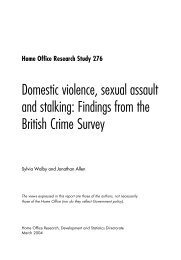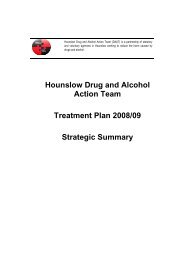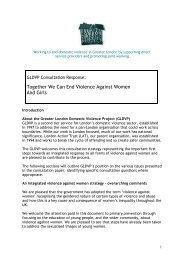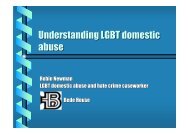1 Domestic violence information
Theory and Practice for the Substance Misuse Sector (pdf - AVA
Theory and Practice for the Substance Misuse Sector (pdf - AVA
You also want an ePaper? Increase the reach of your titles
YUMPU automatically turns print PDFs into web optimized ePapers that Google loves.
MARAC attendance and decision making<br />
Those attending the MARAC should have the authority within their<br />
agencies to prioritise the actions that arise from the MARAC and to be<br />
able to make an immediate commitment of resources to those actions.<br />
The victim does not attend the meeting, nor does the perpetrator,<br />
or the Crown Prosecution Service. The victim is usually informed<br />
that their situation will be discussed by the MARAC, unless doing<br />
so would jeopardise the victim’s safety.<br />
On average the MARAC will spend about 10 minutes per case.<br />
This does underline the importance of the role of the IDVA within<br />
the process.<br />
The MARAC would usually be chaired by an officer from either the<br />
police or probation services. This is normally someone with the rank<br />
of Detective Inspector or equivalent. Contact your local <strong>Domestic</strong><br />
Violence Coordinator for more <strong>information</strong> (see pg 311).<br />
Protocols on <strong>information</strong>-sharing will have to be drafted and<br />
adopted by all agencies.<br />
3.6.3 Information sharing<br />
Always share <strong>information</strong> to protect the safety of a survivor and their<br />
child(ren). If it is not for this reason, then do not share it. Information<br />
should not be shared for the sake of sharing <strong>information</strong>.<br />
Detailed guidance on sharing <strong>information</strong> in a multi-agency context<br />
is available in the service provider resources section of the GLDVP<br />
website www.gldvp.org.uk<br />
3.6.4 Safety planning<br />
By raising the issue of domestic <strong>violence</strong> practitioners can create<br />
opportunities to explore ways in which women and children can be<br />
safe. Safety planning involves more than assessing potential future risk;<br />
it can help create psychological safety, the space needed to recover<br />
and freedom from fear. A safety plan is a semi-structured way to think<br />
about steps that can be taken to reduce risk before, during and after<br />
any violent or abusive incidents. It is important to stress that although<br />
a safety plan can reduce the risks of <strong>violence</strong> they cannot completely<br />
guarantee safety.<br />
“My ex-boyfriend were a control freak, he were a lot older,<br />
and I were a lot younger at that stage, and I think he wanted<br />
to be in control more. He was always in control of the drugs,<br />
like. He’d get the drugs and he put it on the spoon, he’d cook<br />
it up, he’d draw the drugs up into the pin and that and like he<br />
wanted to be controlling me, always had to inject me.”<br />
(Survivor’s voice) A<br />
Internet Chatroom<br />
“I remember you saying to me on one post ‘if you knew that<br />
when you drank you hurt someone you loved, would you still<br />
drink?’ I will always remember that, it marked a turning point<br />
for me, because it brought it home to me that he KNEW he<br />
beat me when he drank and for all the times he said he loved<br />
me, if he truly loved me and didn’t want to hurt me he would<br />
stop drinking.”<br />
http://messageboards.ivillage.co.uk/n/mb/message.asp?webtag=iv-ukrlabuse&msg=27714.7<br />
132<br />
© Stella Project Section 3 - <strong>Domestic</strong> Violence<br />
© Stella Project Section 3 - <strong>Domestic</strong> Violence 133












